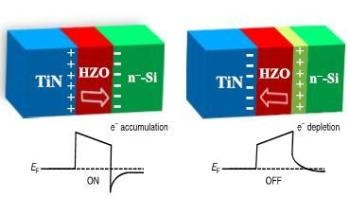Apr 18 2016
MIPT scientists have successfully developed ultra-thin ferroelectric films that are 2.5-nanometres. These films were formed based on hafnium oxide that is capable of being used for developing non-volatile memory elements known as ferroelectric tunnel junctions. The results of this research features in ACS Appl. Mater. Interfaces.
 Information is written by applying an external electric field, which changes the direction of the ferroelectric's polarization vector, and this in turn changes the shape of the potential barrier. Information is read by measuring the tunnel current, which depends on the shape of the barrier. (Credit: Image courtesy of the authors of the study.)
Information is written by applying an external electric field, which changes the direction of the ferroelectric's polarization vector, and this in turn changes the shape of the potential barrier. Information is read by measuring the tunnel current, which depends on the shape of the barrier. (Credit: Image courtesy of the authors of the study.)
Humans are continuously increasing the volume of processed and stored information. Statistics reveal that this information is actually doubling every 1.5 years. The information can be stored with the help of huge amounts of computer memory, which specifically refers to non-volatile memory that helps storing information even during power outage. More compact and rapid storage devices are in the process of being developed by scientists from different parts of the world. The most ideal device would be a "universal" memory, with the non-volatility of a flash drive, the capacity of a hard drive, and the speed of RAM.
There are a number of popular principles that are capable of being used to build memory, but almost all of these principles have their own disadvantages. This is reason for the existence of varied types of memory in mobile devices and modern computers.
One upcoming development that is yet to be fully implemented refers to non-volatile memory, which is based on ferroelectric tunnel junctions. A ferroelectric is a material that has the potential to remember an externally applied electric field’s direction, based on the residual polarization charge.
Thin-film ferroelectrics have been regularly used to form non-volatile memory devices, but they cannot be easily miniaturized in order to obtain high storage capacity and density. Thin-film ferroelectrics are made up of materials that known to be incompatible with the production methods used in contemporary microelectronics.
A new concept of memory devices was presented almost 10 years ago following the demonstration of ferroelectric properties in ultra-thin single-crystal films of perovskites. This alternative concept was based on the use of the tunnel effect.
In general, ferroelectrics are insulators and do not regulate electricity. It is possible for the electrons to slip through with a specific probability if the ferroelectric layer is extremely thin, thanks to the quantum tunneling process. The structure’s energy characteristics, which refer to the shape and size of the potential, determine the tunneling probability, and a tunnel current is created by the electrons that travel through. In this case, the movement of the electrons is very much like an obstacle course race, and the obstacle’s size is estimated by regulating the polarization vector, which makes adjustments to the potential barrier’s shape. Information is written when voltage is applied next to the ultra-thin ferroelectric. This information is read by determining the tunneling current.
This type of memory, in theory, is capable of comprising rapid writing and reading speeds, very high density, and low level power consumption. There are also chances of it becoming a non-volatile alternative to non-volatile alternative (DRAM). Modern DRAM has a retention time of about 0.1 seconds, following which the data is either overwritten or lost. An increasing amount of power is needed to use this particular type of memory. Power can be saved by memory based on ferroelectric tunnel junctions. This saved power is specifically used for portable devices that work on batteries. But until recently, all device prototypes based on standard ferroelectrics have not been compatible with silicon technology, which is utilized to develop most of the modern chips.
For the very first time, researchers from MIPT's Laboratory of Functional Materials and Devices for Nanoelectronics along with their colleagues from the University of Nebraska (USA) and the University of Lausanne (Switzerland), have illustrated that polycrystalline alloyed films of zirconium and hafnium oxides comprising a thickness of only 2.5 nm maintain all their ferroelectric properties.
A few years earlier, ferroelectric properties were identified in one of its modifications, despite the fact that hafnium oxide has already been used for developing modern silicon logic chips. In this study, MIPT scientists succeeded in producing an ultra-thin, tunnel-transparent film of this particular on a silicon substrate, while simultaneously retaining the ferroelectric properties.
The Atomic Layer Deposition (ALD) technique was used to grow the film. Currently, this technique is widely used in the production of modern microprocessors. The ALD technique allows the growth of functional layers in three-dimensional structures.
Since the structures of this material are compatible with silicon technology, we can expect that new non-volatile memory devices with ferroelectric polycrystalline layers of hafnium oxide will be able to be built directly onto silicon in the near future.
Andrei Zenkevich, Head of the Laboratory of Functional Materials and Devices for Nanoelectronics
Moving forward, the ferroelectric tunnel junctions will develop the potential to illustrate memristor properties if these junctions based on hafnium oxide are produced. This is considered to be of immense significance for developing electronic synapses, which may be utilized in neuromorphic systems that are presently in the development stage. These systems are made up of a totally different computing architecture, which imitates the human brain’s functioning principles.